
Type F
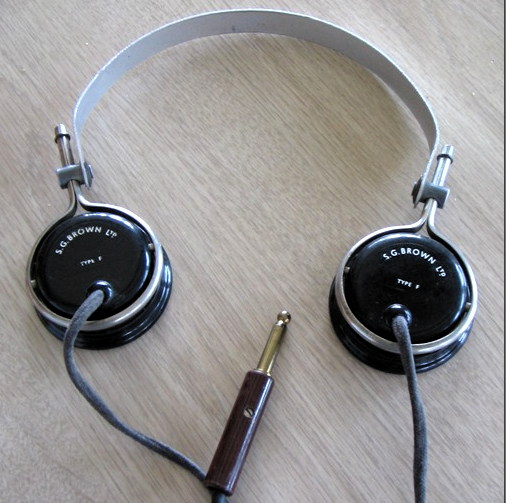
Later Type F (some have double headband as in the early versions)

Type F

Later Type F (some have double headband as in the early versions)
SG Brown Headphones Type F Aluminium earpieces casings and
headbands black earpieces, original twisted flexible leads 2000 ohms
(4000 total). I have three sets of these headphones, one set "patent
applied for " other two "patent 203121" working London,UK. One set has
replacement leads and modern low impedance headphone inserts. Patent
203121 was granted in 1923, so presumably one of the above items was
manufactured just before this date and one sometime later. The type F
was their cheapest model and designed to be lightweight. An early
advertisement refers to them as 'featherweight'
this model latterly incorporated Bakelite housings rather than
aluminium ones and the potentially hazardous bare terminals were
dispensed with.
SG Brown Headphones Type A. I have also been
given a set of low resistance 60 Ohms (120 total) headphones which have
a sensitivity adjustment on the back of each
earpieces. They are each stamped with patent no.29833-10 which refers
to
the 1910 patent. These have aluminium cone shaped diaphragms with a
central screw and although not marked as such I believe that these are
Type A headphones.
SG Brown Headphones Type A2 These are similar in
appearance to the earlier version but have a headband like the Type F.
The one shown below which appeared on eBay has 2000 ohm earpieces (4000
total)
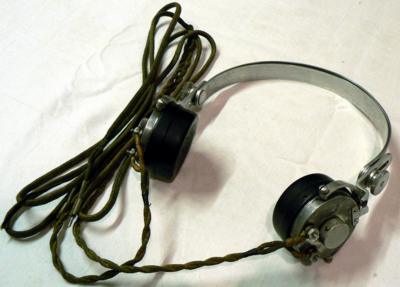
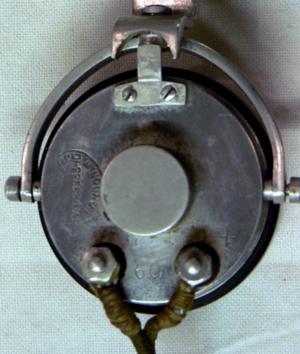
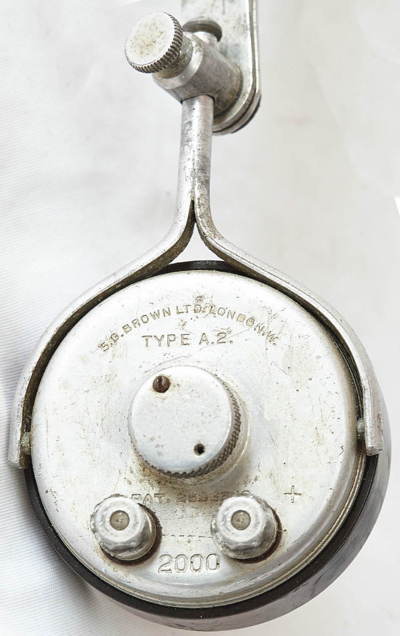
Type
A and Type A2
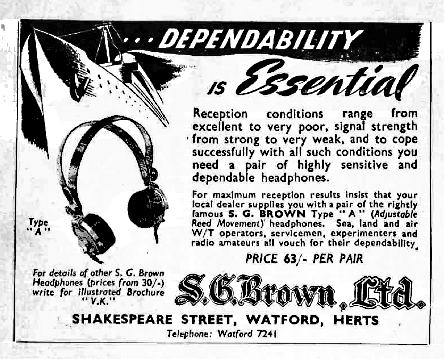
As can
be seen from this 1948 advertisement the same construction was used for
many years
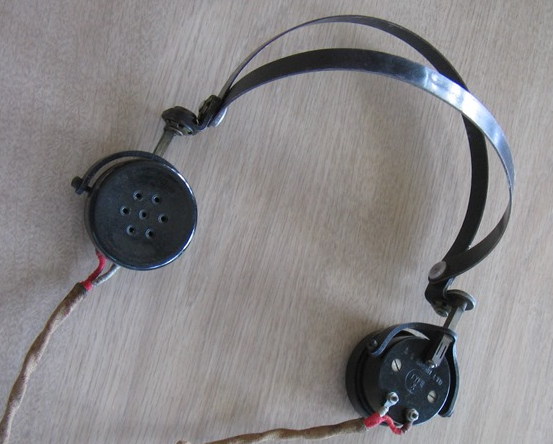
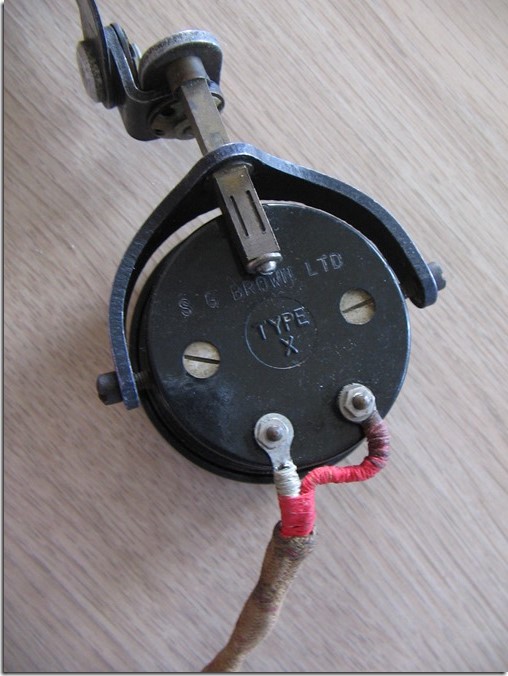
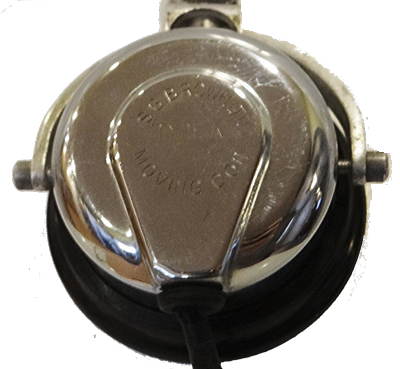
Type
X and Type K (600 ohm)
Over the years other types were introduced
and were available with high and low resistance movements. As far
as I have been able to ascertain
The Type A (adjustable reed movement) was made in three versions (120, 4000 and 8000 ohms)
The Type A2 (adjustable reed movement) was made in one (or more) versions of 4000 ohms)
The Type D was made in two versions (120, 4000 ohms)
The type E reed type designed to resonate
at a certain frequency (useful for CW morse reception)
The Type F (featherlight) was made in two versions (120, 4000 ohms)
The Type G was 4000 ohms
The Type K with moving coil inserts came in 47 and 52 OHM (library record book systems), 600 OHM (military and ham sound powered equivalents), and 4,000 Ohm (vintage equipment).
The Type X was 4000 ohms
Sidney George Brown the company founder was a prolific inventor of electromechanical devices, including the "Microphone Amplifier" (1921) which permitted loudspeaker operation from a crystal set without the use of valves and amongst other things a gyro compass. He set up a business in Watford (North of London) in the year 1910 and in 1915 moved to a larger factory in North Acton, London W3. The company continued making headphones until the 1960's and eventually in the 1980's became part of the Racal organisation which in turn became part of Thales-Racal Acoustics.
The Telegraph Condenser Company (TCC) was also founded by S.G. Brown in 1906. The capacitors they manufactured were almost invariably green and will often be found in early valve radio sets.
Herman Willemsen provided me with images of the type X
and the later version of the Type F shown above.
Simon Ball has what appears to be a 'S.G.BROWN LTD type F microphone which he has used to do some recording. It looks as if it would be a later vintage than my headphones say 1950. The knob on the bottom is a volume control. Peter Sol advised that it is simply a one sided earphone with a handle such as may have been used in a record shop and is exactly the same device as used in S G Brown type F earphones. Yes it will work as a microphone. Chris Clotworthy advises that it is, in actual fact, a hearing aid typically used in churches in about the 1950s and 1960s for those hard of hearing, driven from the 100v line PA amplifier. He has stripped these out of a couple of churches during sound system refurbishment. Dave Dawson G0ELJ says that he has a similar one but without the volume control (the lead comes straight out of the bottom of the handle), and he understands that this is a 'Ladies' Headphone', the intention being that ladies could listen to crystal sets without their hair being disordered by a conventional headset!!. Indeed, he has seen a 1920's picture showing one of these in this application.
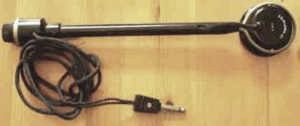
Eric Thorniley recalls that my S G Brown headphones remind him of serious pain in the BBC TV News Studio B at Alexandra Palace where he found himself wearing a pair of trusty SG Browns in 1967. As he recalls the headband had the slotted extendable holder in the picture of the adjustable pair above, but the cans themselves matched the top photo. The pain was cause by the headband which would take a firm grip of a clump of hair so that, when you had to remove them quickly to rush off and do something, the hair was inclined to be left behind with the cans.
Lincoln Rivas from Chile who collects headphones sent me the following files which are of considerable historical interest.
Patent specification of 1910 (420 kB PDF file)click here to read
Patent specification of 1923 (286 kB PDF file)click here to read
OPERATION
The earpieces on the type F headphones (in common with most earpieces of the period) incorporate an electromagnet in very close proximity to a flexible iron diaphragm which is clamped at its periphery. The electromagnet has two coils mounted on the poles of a permanent magnet which prevents frequency doubling of the audio signal. The diaphragms were made of a material called "Stalloy" an alloy of iron, silicon and aluminium which can be easily magnetized and demagnetized as opposed to the "hard" magnetic materials used for permanent magnets. The permanent magnets in receivers can occasionally give trouble if they lose their strength, sometimes this can be rectified by turning over the Stalloy metal diaphragm. It is also worth bearing in mind that if the headphones are connected in a circuit win which there is a DC component the correct polarity must be observed.
The Type A works on the same principle but has an aluminium diaphragm which can vibrate more freely, in this case it is actuated by a small iron reed placed in close proximity to the electromagnet.
It
should be noted
that, in a receiver without a permanent magnet, the diaphragm is
attracted to the pole pieces irrespective of the polarity of the speech
current in the coils. The diaphragm is attracted twice for each cycle
of current. This results in a sound with a frequency twice that of the
original sound and results in the production of harmonic frequencies
which were not present in the original sound. The inclusion of a
permanent magnet increases the
sensitivity of a receiver.
There
is a very detailed description of the theory behind the design in
chapter 3 of "Telephony" volume 1 by J Atkinson MIEE. Pitman 1970

